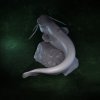Conservation status: Least Concern
The impressive Wels Catfish is the largest-bodied freshwater fish in Europe. Native to central,
eastern and southern Europe, it is also found in parts of western Asia. Its preferred habitat includes
slow flowing lowland rivers, shallow floodplains and weed-covered lakes. It will sometimes enter
brackish waters. Wels catfish will utilize anything available in littoral habitat for refuge including
stony crevices, clay burrows, muddy bottom substrate and aquatic plants. It is most active at night.
Though impressive, the Wels catfish is not a particularly pretty animal. On average they are between
1.2-1.6m in length and weigh between 15-20kg, though they can reach much larger sizes, and have been reported at lengths of up to 3m weighing up to 250kg. The long, flattened snout has widely spaced nostrils
and long barbels on either side of the upper jaw and four shorter barbels on the lower jaw. It has a
stout and robust body with powerful pectoral fins positioned behind the gills. The elongated anal fin
is over 50 per cent the length of its body. The skin is very slimy and upper scale colour will vary
depending on the environment. Catfish living in muddy environments are typically brownish-green,
whilst those in clearer water are more commonly black. All catfish have a pale-yellow underbelly.
Lifespan is typically 15-30 years but the maximum recorded age is 80 years.
Wels catfish are ambush predators with a broad omnivorous diet. Although they have poor eyesight
they are able to rely on their barbels and olfactory senses to locate prey. Their diet includes worms,
insects, gastropods, molluscs and other fish, which are swallowed whole. Large catfish will also take
frogs, aquatic birds and rodents.
Female catfish can produce up to 30,000 eggs per kilogram of body weight during spring spawning.
Males will actively protect and defend the nest until the brood hatches, which can take anywhere
from three – ten days depending on the temperature of the water. Males will keep the eggs well
ventilated by fanning his tail until they hatch. Larvae are only 8.5mm long when they hatch but will
grow to 30cm long in their first year. Otters, cormorants, waders, and predatory fish such as pike
and zander will prey on young catfish.
Wels catfish are not considered globally endangered as their conservation status varies widely
depending on the region. It is extinct in Denmark and Finland and near threatened in Sweden but
invasive in areas it has been introduced such as Spain, France and Andorra. Strangely, a small but
healthy population of the catfish is known to be living within the Chernobyl exclusion zone.
Pre-Supported in Large Scale and Mini Museum Scale
This model comes with two pre-supported versions allowing for easy resin printing; a large sized model, and a 'Mini Museum' size, perfect for collecting and display. The chitubox files are also supplied if customisation of supports is required.
As this model contains many fine details and delicate parts, care is recommended when removing supports to avoid damage.
Clipping off the supports before cleaning up with a sharp blade or file is the best method.
Hollowed Version
This model includes a hollowed version. The hollowed version is made available in order to reduce the amount of resin consumed.
If printing hollowed, curing the inside of the model is recommended.
All images of test prints were made with a Phrozen Sonic Mini 4k with a layer height of 0.05mm

















